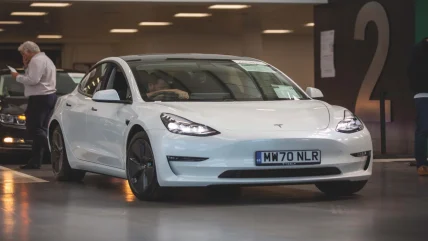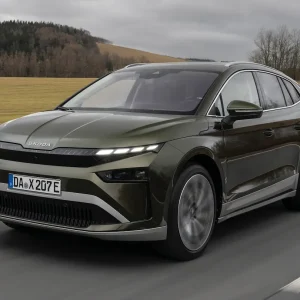
With manufacturers now claiming new car supply is getting back to normal, we ask Thompson if Aston Barclay has noticed any changes.
He says: “From our perspective, the new car market recently posted its longest period of uninterrupted expansion. Registrations have grown by 17%, or 145,000 units, taken from SMMT figures. That shows 10 consecutive months of new car growth, which, let’s face it, is fantastic for our business and the industry.
“Large fleet registrations are continuing to drive the growth within our industry and that reflects the stabilisation that we’re seeing following the challenges post-Covid, which also had an impact on the used car market. More ex-fleet cars are returning, and they are selling well and fast – which is what we want to see. Smaller business fleets are increasing, I think they’ve had a year-on-year rise of around 22%. We speak to these fleets, small or large – and they’re all seeing an increase in new car supply – which reflects in the used car market.
“We are seeing a mixture of ex-fleet vehicles coming off their standard contracts, plus some extension vehicles as well. Over the next couple of years, it will stabilize more, again down to improvements in new car supply. Some of the leasing companies that we’ve dealt with for many years, had a reduced volume coming through to us last year, although this was negated with high prices they were sold for.
“I don’t think we’ll go back to pre-pandemic levels, and I think the way the market was pre-pandemic has gone. This is our new normal now, and I think we all have adjusted to this new normal quite well.
“What’s helped with stocking these older cars, is better manufacturer warranties, and people have looked after them better. The mileage of the vehicles coming through hasn’t massively changed since before Covid. It really depends on the use because more people are working from home than before. There is a difference, but it’s not a drastic one.
“In quarter two, the average mileage on a fleet vehicle being sold at Aston Barclay was 36,000 miles. The average age of a typical fleet car was 42.3 months. So, the age has gone up from a couple of years ago, and the mileage has stayed steady.”
Thompson goes on to discuss the daily rental market, which has been through the same sort of turbulent times.
He says: “It has been a challenging period for the daily rental market. We saw daily rental business coming into our market to buy nearly new and used vehicles – both for car and LCV. That was all due to the supply constraints.
“They were having to take those two- to four-year-old vehicles, to fulfil their business needs. As new car supply comes through, and vehicles become more readily available, I think we will see a reduction in the number of vehicles they buy from ourselves.
“I think the manufacturers are all thinking about this. The question is who is going to break rank first? Who is going to fill those order books and deal with the rental companies? There are a couple of them that are talking about it or doing it in small numbers. This plays into the hands of new manufacturers coming into the UK market, who have an opportunity to jump in first, because they don’t have as many market commitments.
“I don’t think we’re going to get back to levels of daily rental that we used to see, we’ve all got to get used to dealing with things in a different way. The rental companies have adopted more of a fleet policy, where they’ve kept vehicles for three or four years with perhaps 50,000 miles. So suddenly, they’ve been entering vehicles into the used car market that have been competing with fleet vehicles. It is a sweet spot where dealers want to buy, and it has been a good thing for the market.
“What we see with these rental returns, is a difference in condition. If you’ve got a vehicle on lease for two or three years, and one owner, that’s mainly got motorway miles, it will typically come back in a good, healthy condition. The difference would be most of the daily rental has changed hands many times, putting extra strain on that vehicle over a period. It is not normally mechanical issues that we see, but these would probably need a little more TLC.”
Next, we talk to Thompson about the pressure on second-life EV values, that we keep on reading about.
He says: “Most people are aware of the significant movement in the used EV market over the last six to 12 months. However, I would say EV pricing has recently stabilised. What that is doing is giving confidence to the buyer and vendor, and to the end user. Certain makes and models now look reasonable value for money after they have received nine months of price reductions, and what I think that has done, has made EV buyers more confident when they’re about to purchase these vehicles.
“Vehicles with shorter range have typically struggled in comparison with Tesla, which does have a documented greater mileage range and a better charging infrastructure around the UK.
“At Aston Barclay we now hold an EV-only sale, plus we’ve collaborated with industry experts including the Energy Saving Trust, so we’ve been holding workshops and will continue to do so for our buyers and vendors. We’re even reselling Octopus Energy stock. Sharing industry knowledge and expertise is one of the ways that we can help our buyers boost sales. The more confidence we give those buyers, then the more EV sales will come through and that’s proved to be the case with the auctions that we’re seeing.
“The reduction of Tesla prices might not have been popular, but it has re-energised the market. We’ll have to see where the prices are going, but they are within the realms of everyone’s budget now.
“The more EVs that come into the marketplace, the more the pricing will align itself to where it needs to be. Teslas are still fetching very good money in the auction, along with all the other OEMs and brands. I think that’s down to increased media attention on EVs. The market needs to embrace the fleet’s sustainable approach, and when they do this we will see a significant increase in EVs that come into the wholesale market.
“It is important that the government keeps pace with the charging infrastructure targets to increase consumer adoption of EVs. Public charging locations simply need to increase – that will give the public greater confidence in EVs and that’s what we need. Confidence for the buyers and confidence for the end consumers. That for me is the sort of incentive that they need to look at – removing barriers such as range anxiety, and therefore increasing confidence, is key to taking consumer demand to the next level.
“The Government has only focused on the front end, or new EVs for incentives. However, the used market is essential for the new market to succeed and flourish so I think there will be more pressure on the government to support the used market as well.”





